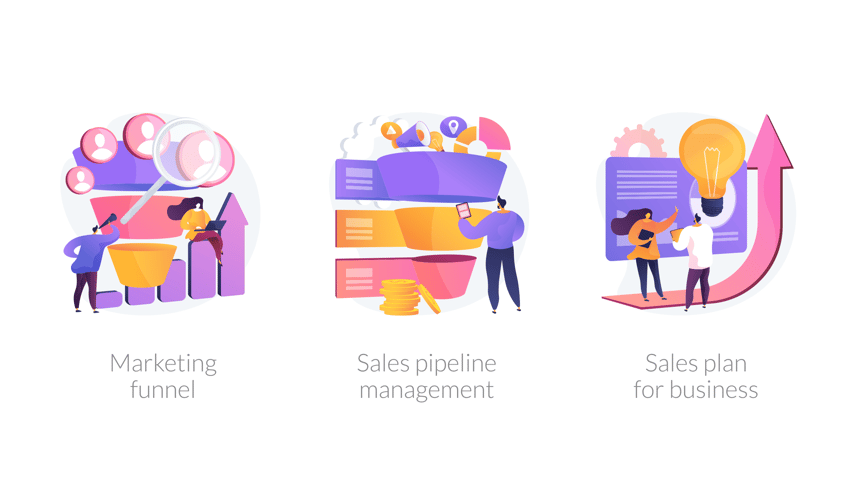Episode 33 - How Project Management can be a Game Changer for Your New Bank or Credit Union Website Project


Don't Miss An Episode, Subscribe Now

When it comes to managing the development of a new website for your financial institution, we recommend a collaborative effort between:
- Your Financial Institution
- Third Party Marketing Agency
- Web Design & Development Company
Although your financial institution could directly partner with a web development company, we've learned how important it is to have the right content (marketing) expert to bridge the gap between your website's goals, content delivery, and overall design framework for the launch of an effective digital branch.
Transcription:
If you're looking for best practices for your bank or credit union, join us while we talk all things sales, marketing, and strategy for financial institutions. Let's make it happen with FI GROW Solutions.
Meredith Olmstead:
Hi there, my name is Meredith Olmstead, and I am the founder and CEO of Fi-Grow Solutions. We are an inbound marketing and sales agency, we work exclusively with banks and credit unions, and I am here with our chief of strategy, Penny Vanderbush. Say hi, Penny.
Penny Vanderbush:
Hey there.
Meredith Olmstead:
So Penny and I were just having a great conversation about the value of having a content expert, and specifically that really, really focuses on the project management in a new website build for a bank or a credit union. And right now we're in the middle of a number of these projects for current clients and new clients, all financial institutions. And so we were having a great conversation and we thought we would push record and just talk about what is the value that really our team as content experts and strategy experts around building a digital branch, what's the value that we bring when we work with a client financial institution and our design and development partner. It's like three of us, there's a triangle of us working together to build a digital branch. So Penny, what's the point? It seems like there might be some extra people in the mix there, but honestly we find it really works well. So talk to me about that.
Penny Vanderbush:
Yeah. So I think first and foremost, as a financial institution you can certainly seek out a website design and development company and partner directly with them. A lot of people do that. Where we think that there's a missing piece to that triangle, if you will, is having a third party agency, the individuals who fully understand and have the industry knowledge for banks and credit unions, who can come into the mix and create the right groundwork for teamwork and collaboration and bring that level of expertise to the mix. Because there's a lot of examples where we have seen, so keep in mind we talk to a lot of banks and credit unions regularly, we talk to developers and development agencies, and a lot of the times what we see happening with a direct relationship is, because there's money involved And the bank or credit union is paying that development company directly, a lot of the times they might make decisions just to make the client happy.
So someone at the bank or credit union might have this idea, it'll have a certain module on their website or have it perform in a certain way, and they push for it, and then the development company might just deliver to make them happy. And there wasn't a third party involved to to say, "Let's step back, let's talk about the strategy. What are your revenue growth strategy? What is the marketing strategy? What is your lead generation strategy for your sales team? And is this extra development in alignment with that strategy?" And that third party voice being the moderator, mediating the situation, eliminates some of that reaction you get when you have that direct relationship. So the role really supports both the design and development company from just taking orders and ad hoc developing items and throwing them on a digital branch trying to make people happy, and really supports that client in making sure that what they get at the end is a quality digital branch that's in alignment with their goals.
Meredith Olmstead:
Yeah. And so the way we have been running our projects this year, just for people's information, from a project management perspective, is that I tend to really focus on big picture strategy but also team building, introductions, making sure people know who's involved throughout the project, helping drive the design process forward, and getting really, really quick and timely review. So that's my area of expertise. So a project manager who starts the process needs to be really good at managing people, at massaging situations, at giving gentle pushback on an idea or a look and feel or a design, but continuing to help motivate people, not discouraging people. And then what happens is once we get through the design phase, our second project management role is really in the technical expertise behind the scenes.
So that you understand your financial products and services, you understand the team now, the look and feel you're trying to go for, all of those elements that have been decided, the site map, that kind of thing. And then you have the technical expertise that helps everybody stick to what needs to be delivered for a compliance reason and keep things moving. So I think absolutely, a lot of it is really almost like touchy-feely, like, "Let's all get along, let's work together, let's create a team." And keeping the big picture involved but having that expertise in the background so that people aren't just saying, "Sure, we can do that. Yes, we can do that." Just giving them something they want, but maybe it's not something they need or it's not in the best interest of the long-term strategy of their digital branch.
Penny Vanderbush:
Yeah. And I think we see that a lot in the quality of SEO. So for example, because we only work with financial institutions, we have a massive ongoing digital library of keywords, keyword search volume, trends for every product line that a financial institution offers, and we're working with that daily. And so we recently had a build that we're in the process of where the financial institution requested a very small site map where they wanted to add multiple products onto a page. A development company could easily say, "Well, sure, we can create you a page of all of your personal consumer loan products lined up on one page and we can make it look fantastic, and we'll put the keyword in on those modules, say in the header sections," and they would deliver what was asked. Everybody would be probably pretty happy with the overall design look and feel and the page itself.
But the problem is, that's not going to perform. And so when you have somebody in the mix who can come to the table with data to say, "You don't want to combine all your products onto one page. There is significant value in having a well designed, appropriately coded site map that Google can look and say, 'This site, this domain has a lot of authority on this subject and I can see that there's resources here around, let's say mortgages. And I can understand from the way that this page was designed and the code behind it that there's information here about the product itself. There's mortgage rates, there's mortgage resources, there's FAQs.'" Maybe you have some schema markup helping Google understand what's happening on that page.
So when you have somebody in the midst who is regularly deep in the weeds of SEO and everything that entails, it can prevent scenarios where a client has this idea to combine a bunch of stuff. A developer just agrees like, "Sure, we can do that. No problem." And then at the end you end up with a digital branch that doesn't perform. So I think that's a huge piece, that when we are in those conversations with the developer and the client, that we're bringing to the table where both parties are going, "Oh, right, that will make sense."
Meredith Olmstead:
Reel it back, it reels it back in. So at the end of the day, really what we're trying to achieve is a situation where we lean on designers for their strength of expertise, which is design. So designers get to be designers. We lean on developers for their strength of expertise, which is development. So developers get to be developers. And then content area experts in financial products and services can be financial experts, can be content area experts. You're not trying to make a designer make strategic decisions about a digital branch for a bank. The strategy there in a designer's mind, really that's not their strength. So it's great when you have enough people in the mix in a digital branch build or new website redesign where you can really let people lean into their area of expertise and not have to make decisions outside of a topic or suggestion that they really don't know that much about.
Penny Vanderbush:
Right. And it's hard to have a project manager be a single person in this scenario. So a lot of development agencies will be like, "Oh yeah, we'll assign you a project manager." Well, that project manager is not only managing your website, but they're managing five others across multiple industries. And so when we're talking project management or involving a third party agency like us, it's not one person. It's a team of experts in paid digital advertising and website build and content and strategy and lead generation and understanding bottom line revenue production out of the digital branch. There's so much more to it than your traditional idea of a single person managing a project, basically making sure it stays on timeline.
Meredith Olmstead:
100%. Awesome. All right, great conversation. Thank you so much, Penny. If you guys are interested, we still have our Fi-Grow Academy that has lots of great classes you can take to learn more about building websites, about digital ads, about content online. And we also have our website, figrow.com. We offer a lot of services, including website project management and content creation, building new digital branches. We're loving those projects, so feel free to check out what we do on our website, and in the meantime let's all get out there and make it happen.








Blog comments